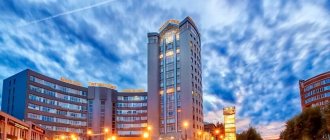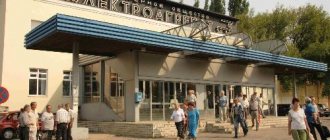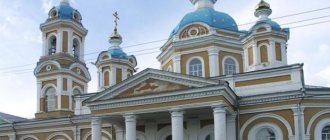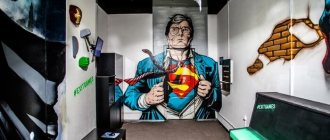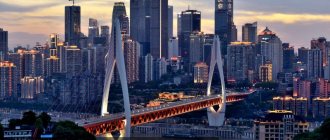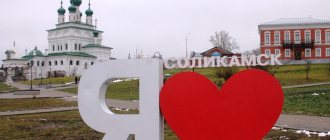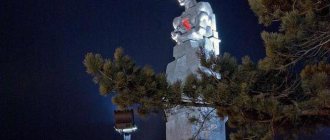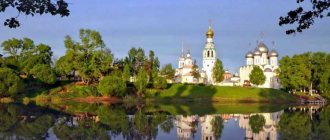| Sights Religious buildings Museums Stories, routes and tips from tourists with photos Where to stay in Kursk Excursions from Kursk for 1 day |
Kursk is the administrative center of the Kursk region and Kursk district. In the Middle Ages it was the heart of the Kursk Principality. Today it is one of the important transport hubs of the country, a city with rich scientific, educational, cultural and religious potential.
It takes quite a long time to get from Moscow (558 km) and St. Petersburg (1219 km), but the city is still worth including in a tourist route to explore the southwestern regions of the country. The trip will be less time-consuming for residents of neighboring Bryansk, Oryol, Lipetsk, Voronezh, and Belgorod regions.
Bus Moscow - Kursk Train St. Petersburg - Kursk
Tourists in Kursk do not particularly need to stay longer than 1 day: this is enough to see the cultural and historical sights, take a leisurely stroll through the historical quarters, and visit several museums and galleries.
The compact location of the main historical, cultural and religious attractions of Kursk allows you to explore them in one day. You can devote your evening time to a concert, performance, or getting to know some museum collection.
Travelers with children can head to the local water park . Another good option to end the day is a visit to the Central Park shopping center , on the top floor of which there is a huge Play Ventura amusement park (a real haven for children of all ages), and on the roof there is an observation deck with excellent views of the city.
The main thing is to plan your route in advance in order to accurately meet the allotted hours. A detailed guide to Kursk for 1 day with descriptions of attractions and reviews from tourists is below.
What to see in Kursk in 1 day on your own
Kursk is associated primarily with one of the key battles of the Second World War and the Great Patriotic War - the Battle of Kursk. The largest tank battle involved 6 thousand tanks and about 2 million people, as well as 4 thousand aircraft. The Kursk Bulge Memorial Complex, 7 km from the city center, is dedicated to the outstanding event Its opening took place on July 5, 1998 and was timed to coincide with the 55th anniversary of the Battle of Kursk. Objects of the complex - the Triumphal Arch, the stele “Kursk - City of Military Glory” , the alley of military equipment from the Great Patriotic War, the monument to Marshal G.K. Zhukov, the granite tombstone of the “Unknown Soldier of the Kursk Land”, the Church of St. George the Victorious , inside which there are about seven thousand plaques with the names of Soviet soldiers who died on the Kursk Bulge. The memorial complex stretches for almost 2 km along Pobeda Avenue.
Photo: © Igor Butyrskii
If you arrived in Kursk by train, do not rush to take the next bus to the center. Examine the railway station . The very first station was destroyed by German aircraft in the summer of 1943. Instead, in 1952, a new terminal of the Kursk station was built according to the design of the architect Igor Yavein. The building is decorated with figures of workers and soldiers, there are memorial plaques on the external walls, a sculpture of a warrior is installed in the waiting room, and its walls are decorated with a bas-relief “Battle of Kursk”.
Kursk's main non-wartime attractions are concentrated in and within walking distance of Red Square
Perhaps it’s worth starting with Lenin Street , the central street of Kursk.
The development of this part of the city looks generally organic and does not discord with modern buildings.
At the intersection with Marata Street there is a single architectural ensemble formed by the building of the Central Hotel and the City Council building (1957). Now the City Council building houses the Administration and all sorts of committees.
The Internal Affairs Directorate building on Lenina, 5 (1948) and the House of Books on Lenina, 11 (1956) are architectural monuments, as is the City Council building.
Behind the House of Books there is an unusual monument in the shape of an apple - the Kursk "Antonovka" . The metal apple, created by local sculptor Vyacheslav Klykov, weighs 150 kg. Kursk, as you know, is the land of apples, which is what the author wanted to say.
Photo: © Igor Butyrskii
If you walk further along Lenin, you will find yourself near the Kursk Drama Theater named after A.S. Pushkin . The building was built in 1983. On its roof there is a bronze sculpture of the goddess of victory Nike, at whose feet are two theatrical masks and in her hand is a palm branch. The theater's repertoire includes about 20 performances based on Russian and foreign works. The capacity of the hall is 1000 people. a monument to A.S. Pushkin on the square in front of the theater .
Even further along Lenin there is an unusual building of the Main Directorate of the Bank of Russia for the Kursk Region (house No. 83). It was built in 1913 according to the design of the architect F. O. Livchak. Initially, the Peasant Land and Noble Banks were located here. During the years of Soviet power, Karl Bauman sat in one of the offices. In the post-war years, an extension was erected, and a vestibule with columns and stucco molding appeared. In 2001, a large-scale restoration was carried out.
Directly on Red Square is the building of the Regional Administration - the former House of Soviets , built in the classicist style (1941). Opposite is the House of Communications (1960), now the Central Post Office. You can come in and send a postcard with views of the city. The Zero Kilometer of the Kursk Region was installed in front of the post office .
Quite expectedly, there is a monument to Lenin (1993) on the square.
The only residential building on Red Square is the six-story residential building No. 2/4 , built in 1961.
If you turn onto Dzerzhinsky Street, you can go to the Puppet Theater , which is located in the building of a former gymnasium. The theater’s repertoire includes about 40 productions - for children from 3 years old (“Ryaba the Hen”, “Tsokotukha Fly”, etc.) and from 6 years old (“Thumbelina”, “Puss in Boots”, etc.).
If you wish, you can visit the May 1st Park - ride the Ferris wheel or just relax on a bench.
In the area of Sonin and Lunacharsky streets there are several attractions - the Znamensky Cathedral , the Church of the Resurrection of Christ , the defensive structures of the Kursk Fortress of the 17th century, the remains of the monastery fence, the Bishop's House (Museum of Local Lore).
Against the backdrop of all this, the brick building of the Assembly of the Nobility , built in 1877 in the eclectic style, stands out. It was reconstructed several times, but the facades were preserved in their original form. Currently, the Sviridov Arts Center (a branch of the Kursk Regional State Philharmonic) and the Kursk Regional Planetarium .
Moving along Sosnina Street, you will come to Soviet Square, where the Kursk State Circus . The opening took place in 2011. In front of the circus building there is a monument to Soviet clowns Yuri Nikulin and Mikhail Shuidin.
Photo: © Igor Butyrskii
While exploring the city, you should definitely visit the Art Gallery named after A. A. Deineka . It opened in 1935, and since then its holdings can rival the best art galleries in the country. In total, about 10 thousand works are stored here, which took part in many international exhibitions. Here you can see works by Barocci, Breidel, Tiepolo, Levitan, Schwartz, Polenov, Trutovsky, Kuindzhi. In addition to painting, graphics, engravings, sculpture, embroidery, icons, and porcelain are presented. The central collection is dedicated to the works of Alexander Deineka, a native of Kursk.
Bus ticket price Moscow - Kursk
The cost depends on the carrier and varies from 900 to 1,150 rubles . A child ticket for a child under 12 years old with a separate seat costs half the original amount. Hand luggage is placed in the cabin free of charge. If luggage exceeds the permissible limits, its transportation in the luggage compartment is paid additionally.
You also need to add a service fee to the ticket price if you decide to make a purchase online.
Religious buildings
There are several religious buildings located within the central part of the city. The main one is the Znamensky Cathedral , the construction of which was timed to coincide with the victory in the War of 1812. It received its name in honor of the “Sign” icon, brought here from the Root Hermitage on the opening day. The cathedral is located in the very center of Kursk on the territory of the Znamensky Monastery.
Photo: © Igor Butyrskii
Next to the cathedral is the brick single-domed Church of the Resurrection of Christ , built in 1875 with donations from townspeople. In the 1920s, it was closed for worship until the early 2000s. Currently under restoration.
If you walk from Red Square up Lenin Street (and parallel to Maxim Gorky Street), you can see several more churches - Resurrection-Ilyinsky Church , Holy Trinity Church , Sergius-Kazan Cathedral .
A notable religious building is the Church of the Assumption of the Virgin Mary . It was built in 1892-1896. in neo-Gothic style. It is curious that it was here that the artist Kazimir Malevich, who lived in Kursk for about 10 years, got married and baptized his children. The house where he lived has been preserved in the city - the House of A.F. Bezhodarny at 17 Pochtovaya Street. Residents and guests of the city can visit the church and listen to an organ concert.
Photo: © acvazul-v2010
If you have time, it’s worth getting to the Temple of the Holy Royal Passion-Bearers . This is a relatively young five-domed temple, built in 2008-2010. using motifs from Vladimir ancient church architecture. The temple is operational, and believers can attend services.
Not far from Dobrolyubov Square rises the majestic Church of the Life-Giving Trinity .
The holy place of pilgrimage is the Korennaya Pustyn Monastery on the banks of the Tuskar River, 33 km from the center of Kursk. It was founded in the 13th century on the site of the miraculous discovery in 1295 of the icon of the Sign of the Blessed Virgin Mary on the root of a tree. Currently, the original icon is located in the Znamensky Cathedral of the Russian Orthodox Church in New York.
Among the shrines of the monastery are a large reliquary with the relics of the venerable Kiev-Pechersk and Optina elders and two relics with the relics of saints, saints, righteous people and martyrs.
Photo: © acvazul-v2010
Bus Moscow - Kursk from Novoyasenevskaya
Photo: © ShelobaevAlexey
There is only one bus from this bus station every day at 22:00. It takes 7 hours to get to Kursk. The flight is passing to Belgorod. Carried out by private carrier IP Fedotova E.P.
Ticket price - from 1,000 rubles .
- Details on the bus station website
Consider trains as an alternative means of transportation. They leave from Kursky Station and travel from 5 hours to 9 hours 25 minutes. Read more in this material.
Museums of Kursk
The city is not very rich in various kinds of museums, but this fact should not be misleading. The exhibitions are thematically diverse and dedicated to the history and culture of the country.
In the historical center there are both large museum complexes and small exhibition halls. A visit to one museum will usually take about 40 minutes to 1 hour. If you only have one day left, it is worth stopping at one museum so that you have time to see other attractions.
At the same time, it should be taken into account that not all collections are equally interesting and informative: in reviews of Kursk, tourists share their impressions. What museums in Kursk are worth visiting?
Kursk Regional Museum of Local Lore
The Kursk Museum of Local Lore is the largest exhibition site in the region. His collections introduce nature, history and outstanding personalities of the Kursk land. In addition to the permanent exhibition, the museum hosts temporary art and scientific exhibitions.
The archaeological and ethnographic collections, items from which have been collected over many decades, deserve special attention. Interesting are fragments of a traditional hut, various household utensils and memorable costumes of Kursk residents. A special hall is dedicated to the events of the Great Patriotic War.
The museum is housed in the Bishop's House , built in 1833.
Kursk Literary Museum
In 2009, a branch of the Kursk Regional Museum of Local Lore, the Literary Museum . It is located within the walls of a historic mansion that once belonged to merchant Sofya Davydova. On the ground floor there is an assembly hall, an exhibition hall and a library, and the entire second floor is given over to the exhibition. Eight thematic halls tell both about individual authors (A. A. Fet, N. N. Aseev, K. D. Vorobyov, E. I. Nosov) and about the literary movement as a whole.
Kursk Museum of Archeology
Another notable museum worthy of a visit is the Kursk State Regional Museum of Archeology . Its collection contains many exhibits discovered during field research. Many collections have not only regional, but all-Russian significance. The central element is a diorama describing the life of people who lived on the territory of Kursk about 22 thousand years ago.
The museum building itself is an architectural monument known as the House of Merchant Khloponin. It was built in the 18th century and is considered one of the oldest stone structures on the territory of Kursk.
Photo: © Kursk Museum of Archeology
Archive number No. 37 (467) dated September 16, 2003 - News
EXCURSION INTO HISTORY
Those who pass through Kursk say: “What an old city you have!” No wonder they say. After all, on September 25, the regional center will turn 971 years old. As the well-known wisdom says: “Moscow was still in its cradle, but Kursk was already fighting for Moscow.” In reality, little remains of the old city.
At the regional museum of archeology we were told that if we take the buildings of the pre-revolutionary period as old ones, then their ratio to new buildings is 1 to 500. The most ancient districts of Kursk are Streletskaya, Yamskaya, Pushkarnaya and Kozatskaya settlements, but even here there are almost no old houses left. After all, living in an architectural monument is not profitable; it is cheaper to build a new house. The same picture is on the oldest streets: Dzerzhinsky (formerly Kherson) and Lenin (formerly Moscow), which were practically rebuilt after the war. During an inventory in the 18th century, 26 stone buildings were counted in Kursk. Today, one of them has been preserved - the current museum of archeology.
According to legend, it belonged to the Moscow princes Romodanovsky, who ruled Kursk in the 17th century. Therefore, sometimes it is called the “Chamber of the Romodanovsky Boyars.” And although it has been proven that the house is no more than 260 years old, the beautiful name stuck. Of the non-residential buildings, the creation of which dates back to the mid-18th century, the Lower Trinity Church and St. Sergius-Kazan Cathedral still stand.
Much more buildings from the 19th century have survived. A striking example of this is a small two-story house at the intersection of Sadovaya and Lenin streets, where there is now a bookstore. The founder of the Kursk biofactory, Dikovsky, lived there. Nearby is the building of the diocese, a former teachers' seminary built in the second half of the 19th century.
If you go higher, on Zolotoy Street, 12, you can see a three-story building built by Count Kleinmichel. There used to be a city psychoneurological clinic there. Its walls, by the way, heard the sound of the steps of the Emperor and Autocrat of All-Russia Nicholas II, who during the First World War, in November 1914, visited wounded and sick soldiers in the military hospital located there.
Opposite the Shchepkin cinema there is a regional drug treatment clinic. In common parlance it is sometimes called the Governor's House. Why? It turns out that during the time of Catherine II, the Kursk governorship was established. A wooden house was built for the governors in the area of Pervomaisky Park and plastered, but it did not last long. Complaints began to come from officials: the roof was leaking, the floors were rotting, the walls were crumbling... Among the Kursk nobles, there was one who, out of respect for high-ranking officials, did not raise the price and sold the stone house on the former Khersonskaya street almost at cost, for 40 thousand. And since the beginning of the 19th century, the official residence of the Kursk governors was located there. There was a house church inside the building. Last year, representatives of the diocese came to the dispensary and tried to find an underground passage that began under the stairs leading to the second floor and was supposed to lead to the church that previously stood near the place where the shoe factory is now located. They examined the walls, which were more than a meter thick, but, unfortunately, found nothing.
There are completely unique buildings, the safety of which, unfortunately, is not monitored, but their loss will be irreparable for the history and architecture of Kursk. This is the small building of the merchant Deryugin - a building behind the burnt circus, consisting of three buildings, on the walls of which pre-revolutionary construction dates are lined with brick. Coarsely ground grain was made there, hence the unusual name for modern people. In Soviet times, the mill was still functioning, then there was a knitting factory there, but now the building is abandoned. There are several offices located in it, and the rest of the territory is in oblivion.
The building of the summer theater of the merchant's garden in Pervomaisky Park is one of the first reinforced concrete buildings in Russia. It’s interesting that when it was built, they planned to make the entrance on the side of the Znamensky Cathedral, that is, in the opposite direction to how it is located now. But, according to the laws of the Russian Empire, the entrance to entertainment establishments had to be at a certain distance (about 100 fathoms) from the church. In order to comply with the law, the architect Peryatyatkovich lacked quite a bit. However, not hoping to defeat the stubbornness of the holy fathers, he simply turned the construction 180 degrees.
Anna NARYKOVA
Share link:
Subscribe to “For Each Other”:
Yandex News Yandex Zen Google News YouTube Video
Stories, routes and tips from tourists with photos
A list of attractions that are worth seeing in Kursk in 1 day can be found in traveler reviews. Tourists share their impressions of the city and give advice on how to have an enjoyable time in Kursk. You can use someone’s ready-made route, or you can create your own based on the recommendations of other tourists. In tourist reports about Kursk you will find photographs of the city at different times of the year, as well as tips on where to eat and where to spend the night.
- The story “Meet Kursk!” (Vladimir)
- Photo album “Kursk” (Igor Butyrskii)
- The story “The image of the Virgin Mary found in the roots of a tree. Kursk Root Hermitage" (NatalyA)
All tourist reviews about Kursk on Turister.ru
Photo: © Igor Butyrskii
Where to stay in Kursk
Hotels and apartments in Kursk are spread throughout the city. In order not to waste time on the road, alternately changing high-rise blocks for a long private sector, it is wise to settle in the central part. Choose the area of Lenin, Radishchev or Dzerzhinsky streets. It is along them that the most memorable places of the city and symbols of Kursk are located.
Two dozen hotels in Kursk have mostly 3 or 4 stars. A larger selection is offered among private apartments and apartments. But there are very few hostels here and they are located closer to the outskirts. One of the countryside options could be an interesting option for a summer trip. The names of the hotels “Nightingale Grove”, “Grove of Brides” and “By the Lake” speak for themselves about their excellent location in a forested area.
- Kursk Hotels
- Hostels for Budget Travelers
- Flats and apartments
When booking accommodation on Booking.com, do not forget about cashback: Cashback promotion for Tourist. RU
Buy a bus ticket Moscow - Kursk
To make sure you don’t end up without a place, we recommend using the online purchasing option. The route we are interested in is connected to the Busfor.ru service, which specializes in searching and selling bus tickets.
All flights from all Moscow bus stations are collected in one catalog, so you can evaluate the carriers' offers by comparing them by cost and travel time. In addition, the carrier's rating is indicated, based on user ratings.
To issue an electronic itinerary receipt, you will need a passport, phone number and mail address where the ticket form will be sent.
When boarding, the controller or driver should provide the original document for which the ticket was issued, as well as a printed form. Children - birth certificate.
The sale opens 10 days before the trip and ends 5 minutes before departure.
